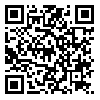BibTeX | RIS | EndNote | Medlars | ProCite | Reference Manager | RefWorks
Send citation to:
URL: http://jdisabilstud.org/article-1-3195-en.html
2- Assistant Professor, Department of Psychology, Faculty of Humanities, Tabriz Branch, Islamic Azad University, Tabriz, Iran
3- Associate Professor, Department of Psychology, Azarbaijan Shahid Madani University, Tabriz, Iran
Abstract
Background & Objectives: Obsessive–compulsive disorder includes mental obsessions, compulsions, or both. Obsessions comprise frequent and intrusive thoughts, impulses, and mental images; compulsions are repetitive objective behaviors (washing hands, keeping order, checking) or repetitive mental activities (counting, chanting, repeating words slowly in silence). The patients feel obliged to do these behaviors in response to an obsession or according to rules that must be strictly obeyed. In the fifth edition of the Diagnostic and Statistical Manual of Mental Disorders, this disorder has a separate class, and its accompanying problems and debilitating symptoms disrupt the individual's interpersonal, occupational, and social functioning and bring significant economic and social costs to the individual and society. Pathological studies have investigated the factors and correlates with obsessive–compulsive disorder to identify the symptoms of the disorder better in the form of cognitive models. A positive and significant relationship between obsessive–compulsive symptoms and mixed thoughts has been reported in many studies, and it has been mentioned as a powerful predictor for the symptoms of the disorder. Obsessions or compulsions are time–consuming, and their problems cause confusion in interpersonal, social, work, and other critical functional situations and bring financial costs to the individual, family, and society. Also, this disorder has a relatively high prevalence. The present study was conducted to predict the symptoms of obsessive–compulsive disorder based on the thought–action fusion and mindfulness in a nonclinical population.
Methods: The research design was correlational analytics. The statistical population of the research comprised all students (boys and girls) of the universities of Tabriz City, Iran (Tabriz Azad University, Tabriz University, and Shahid Madani University). This research recruited a sample of 500 students (accounting for 10% possible dropout) by the available sampling method. Questionnaires were administered individually. Also, to comply with the ethical principles, the code of ethics under the number IR.IAU.TABRIZ.REC.1400.50 was obtained from the Ethics Committee. To collect data, we used the revised obsessive–compulsive questionnaire (Foa et al., 2002) with an internal consistency of 0.85 for its Persian version, thought–action fusion scale (Shafran, Tordarson, and Rachman, 1996) with an internal consistency of 0.81, and the mindfulness assessment scale (Brown and Ryan, 2003) with an internal consistency of 0.85. The Pearson correlation coefficient and multiple regression were used to analyze the obtained data in SPSS version 25. The significance level of statistical tests was considered 0.05
Results: According to the results, the average age of the subjects studied was 24.63, with a standard deviation of 7.2 years. Based on the results, there was a significant relationship between the thought–action fusion and mindfulness with the symptoms of obsessive–compulsive disorder (p<0.001). Also, the results showed that mindfulness and thought–action fusion can predict obsessive–compulsive symptoms (p<0.001). The prediction coefficient of obsessive–compulsive symptoms based on mindfulness was higher than thought–action fusion.
Conclusion: According to the results, the symptoms of obsessive–compulsive disorder can be predicted based on thought–action fusion and mindfulness. It is suggested that in future studies, researchers conduct research using a combination of quantitative and qualitative methods and in a comparative manner. Also, thought–action fusion can be used as a screening and diagnostic tool. Therefore, the results of the present research should be utilized in the design of follow–up and therapeutic interventions.
| Rights and permissions | |
 |
This work is licensed under a Creative Commons Attribution-NonCommercial 4.0 International License. |



